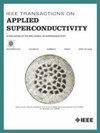Electromagnetic Optimization and Testing of the Vertical Beamline DCT Superconducting Magnet in CLAPA-II Proton Therapy
IF 1.8
3区 物理与天体物理
Q3 ENGINEERING, ELECTRICAL & ELECTRONIC
引用次数: 0
Abstract
CLAPA-II is a laser-driven proton therapy facility designed and constructed by Peking University. Protons are generated through laser–plasma interaction, with a 2-PW laser used to accelerate the proton beam. The beam transport system is capable of transmitting protons with energies ranging from 40 to 230 MeV. The CLAPA-II beamline consists of both a horizontal transport line and a vertical beamline. To provide critical technical validation for the future engineering of superconducting rotating frames, the vertical beamline utilizes curved discrete–cosine–theta magnets, resulting in a lighter and more compact design. The vertical beamline is composed of six modular magnetic units, each containing a 2.77-T central magnetic field dipole magnet with a 900-mm bending radius, alongside two 40-T/m gradient quadrupole magnets in a quadrupole–dipole–quadrupole (Q-D-Q) configuration. This article details the electromagnetic optimization design of the vertical beamline superconducting magnet (Q-D-Q) system. In response to the beam physics requirements, magnetic fields were optimized for both pure coil and iron core models. Structural behavior under 4.2-K excitation was analyzed, and the induced magnetic field distortions due to mechanical deformation were quantitatively evaluated. In addition, excitation testing and magnetic field measurements were conducted on the first magnet in a liquid helium environment. The findings provide key technical support for the design and manufacturing of superconducting magnet systems for future laser-driven proton therapy accelerators, while also establishing the technical foundation for large-scale production.垂直束线DCT超导磁体在CLAPA-II质子治疗中的电磁优化与测试
CLAPA-II是由北京大学设计和建造的激光驱动质子治疗设备。质子是通过激光等离子体相互作用产生的,用一个2 pw的激光器来加速质子束。光束传输系统能够传输能量在40到230兆电子伏之间的质子。CLAPA-II光束线由水平传输线和垂直光束线组成。为了为超导旋转框架的未来工程提供关键的技术验证,垂直光束线采用弯曲的离散余弦磁体,从而实现更轻、更紧凑的设计。垂直光束线由六个模块磁单元组成,每个单元包含一个2.77-T的中心磁场偶极磁铁,弯曲半径为900毫米,以及两个40-T/m的梯度四极磁铁,构成四极-偶极-四极(Q-D-Q)结构。详细介绍了垂直束线超导磁体(Q-D-Q)系统的电磁优化设计。根据束流物理要求,对纯线圈和铁芯模型的磁场进行了优化。分析了在4.2 k激励下的结构行为,并定量评价了机械变形引起的感应磁场畸变。此外,在液氦环境下对第一块磁体进行了励磁测试和磁场测量。研究结果为未来激光驱动质子治疗加速器超导磁体系统的设计和制造提供了关键技术支持,同时也为大规模生产奠定了技术基础。
本文章由计算机程序翻译,如有差异,请以英文原文为准。
求助全文
约1分钟内获得全文
求助全文
来源期刊

IEEE Transactions on Applied Superconductivity
工程技术-工程:电子与电气
CiteScore
3.50
自引率
33.30%
发文量
650
审稿时长
2.3 months
期刊介绍:
IEEE Transactions on Applied Superconductivity (TAS) contains articles on the applications of superconductivity and other relevant technology. Electronic applications include analog and digital circuits employing thin films and active devices such as Josephson junctions. Large scale applications include magnets for power applications such as motors and generators, for magnetic resonance, for accelerators, and cable applications such as power transmission.
 求助内容:
求助内容: 应助结果提醒方式:
应助结果提醒方式:


